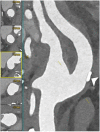Dual Source Photon-Counting Computed Tomography-Part II: Clinical Overview of Neurovascular Applications
- PMID: 37297821
- PMCID: PMC10253695
- DOI: 10.3390/jcm12113626
Dual Source Photon-Counting Computed Tomography-Part II: Clinical Overview of Neurovascular Applications
Abstract
Photon-counting detector (PCD) is a novel computed tomography detector technology (photon-counting computed tomography-PCCT) that presents many advantages in the neurovascular field, such as increased spatial resolution, reduced radiation exposure, and optimization of the use of contrast agents and material decomposition. In this overview of the existing literature on PCCT, we describe the physical principles, the advantages and the disadvantages of conventional energy integrating detectors and PCDs, and finally, we discuss the applications of the PCD, focusing specifically on its implementation in the neurovascular field.
Keywords: computed tomography angiography; energy integrating detector; neurovascular; photon-counting computed tomography; photon-counting detector.
Conflict of interest statement
The authors declare no conflict of interest.
Figures







References
Publication types
LinkOut - more resources
Full Text Sources

